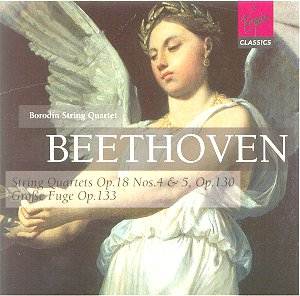Ludwig van BEETHOVEN
String Quartets (1779 -
1827)
 Borodin String Quartet.
Borodin String Quartet.
 Recorded Forde Abbey, Somerset.
June/July 1988 (Op 18/4) St. Martin's Church, East Woodhay. Feb 1989 Virgin
Classics 7243 5 61748 2 5
Recorded Forde Abbey, Somerset.
June/July 1988 (Op 18/4) St. Martin's Church, East Woodhay. Feb 1989 Virgin
Classics 7243 5 61748 2 5

CD1 51.46
String Quartet No 4 in C Minor. Op. 18 No 4 24.41
String Quartet No 5 in A Major. Op 18 No 5 27.02
CD2 56.15
String Quartet No 13 in B Flat Major. Op. 130 40.07
Including Grosse Fugue Op. 133 15.47
There can be few more satisfying musical combinations than the compact disc
and Chamber Music. Nothing can be easier - put the disc in the tray, settle
back, press a button and off you go. If your player is set right and the
recording engineers have done their job correctly then it should be fine.
There's none of the bane of home listening - a huge dynamic recording range
- which can be such a problem in bigger works for those of us who do not
live in baronial halls. And when it's Beethoven, well..........
The material on this new Virgin double CD with the Borodin Quartet in all
Beethoven disc has all been released previously. In their new incarnation
the recordings give listeners who may be fresh to the beauties and challenges
of Beethoven Quartets a safe, if uneventful introduction. More experienced
listeners may well prefer to look elsewhere.
The first CD - 51' 46" only, please note - gives us two of the six Opus 18
quartets, Beethoven's first ventures into the form published in 1801 after
some extensive revisions. The C Minor ( No 4) opens with a brooding, dark
hued Allegro which confirms that the group produces a beautiful, well
matched sound with impeccable intonation. The second movement scherzo
was too po faced and much of the wit was missing. The minuet and
trio with its quicker reprise leads into the cat's-cradle of a high-speed
finale. Throughout the four movements one was always aware of clarity
of the inner parts and the poise and elegance of the playing which never
quite got under the composer's skin.
The A Major Quartet ( Op. 18, No 5) is generally regarded as being inspired
by Mozart's Quartet in the same key, K464. They have much in common, even
to the use of variations in the slow movement. The work is a delight. Its
cheerful, opening allegro gained from a freer use of rubato than earlier,
while the minuet (unusually placed second), was notable for the clarity
of the four lines. I found the andante and the succeeding five variations
lacking the nuances which finally convince. The closing allegro with
its four note motif showed magnificent technique rather than memorable
interpretation.
The B Flat Major Quartet (Op. 130) was originally performed with what became
the Grosse Fugue ( Op. 133) as its final movement, later to be changed
to its present layout with a new Finale. Virgin have chosen to place
the Op. 133 as track 6 on a 7 track side - the true Finale follows
- so the listener needs to programme the disc with care. Using modern technology
one can reproduce the original layout and can see why the 1826 audience was
bemused.
The opening Adagio-Allegro, longer than the next three movements combined
in this unusually constructed work, again showed what civilised music making
the Russians provide. The brief Presto showed that speed and attack
are not the same thing, and the following Andante missed some of the
intended humour. A Landler like Danza tedesca was
gently rhythmical. Beethoven himself was reputedly driven to tears by
the emotional strength of his own writing in the aria like Cavatina,
here played thoughtfully without pulling the heart strings, while the
finale failed to catch fire.
The single movement Grosse Fugue still sounds modern to today's ears,
nearly two centuries after it was written. The early angular theme tests
intonation and technique, handled inevitably with apparent ease, and the
recording clarity helps the ears trying to follow this most challenging of
pieces.
At this point I decided that it was time for comparisons. My yardstick for
the Beethoven Quartets is the set by the Quartetto Italiano on Philips. Just
dipping into the equivalent works showed what was missing. In technique at
this level of musicianship one would not expect there to be any differences.
The Italians simply feel livelier and more alert with more inner vitality
and less 'smoothing out' of the inner parts. Speed alone is not an issue.
In some cases the Italians were considerably slower (e.g. in 18 / 5 Third
Movement, 10.55 against the Russian timing of 8.45. Quite a remarkable contrast).
The difference is in the depth of reading and approach. One feels that the
Borodin's main aim is beauty of sound, whereas the Italian Quartet wants
to get inside the Beethoven score.
Reviewer
Harry Downey


![]()